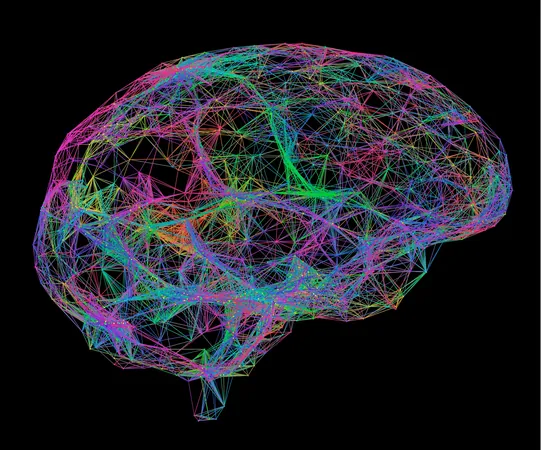
Unlocking the Secrets of Brain Aging: Could Local Cellular Interactions Hold the Key?
2024-12-18
Author: Yu
Unlocking the Secrets of Brain Aging: Could Local Cellular Interactions Hold the Key?
Recent research from Stanford University's Knight Initiative for Brain Resilience has unveiled groundbreaking insights into how local cellular interactions within the brain influence aging. Utilizing advanced techniques like spatial transcriptomics and artificial intelligence, scientists have discovered that some brain cells create a nurturing environment that promotes the health and resilience of their neighbors, while others may contribute to stress and damage, thereby accelerating the aging process.
Published in the prestigious journal *Nature*, the study titled "Spatial transcriptomic clocks reveal cell proximity effects in brain aging," sheds light on how our understanding of brain aging could be vastly transformed by acknowledging the role that cellular neighborhoods play.
Anne Brunet, a leading expert in genetics and co-senior author of the study, expressed her excitement over the findings: "What was thrilling to us was identifying that some cells exert pro-aging effects on their neighbors while others seem to have rejuvenating properties." This duality opens a multitude of possibilities for future research and therapeutic interventions.
Neural Stem Cells: The Unsung Heroes
In a striking revelation, researchers highlighted the role of neural stem cells (NSCs), which appeared to rejuvenate adjacent cells. Brunet emphasized the potential of these cells, stating, “We want to further investigate how NSCs contribute to creating a resilient environment in the brain." Their responsible role extends beyond just generating new brain cells; they seem to actively foster a supportive microenvironment essential for brain maintenance and repair.
Cutting-Edge Technologies in Action
Brunet partnered with James Zou, PhD, and graduate student Eric Sun, employing a synergy of biological expertise and machine learning techniques. The study produced a comprehensive spatial single-cell transcriptomic atlas of the mouse brain, capturing the expression of genes across 2.3 million cells at different life stages—equivalent to human ages ranging from 20 to 95. This atlas served as the foundation for developing a unique computational tool known as a spatial aging clock.
“This clock is revolutionary,” stated Sun. “We can now utilize it to uncover new biological insights rather than merely estimating biological age.”
Another development involved creating a sophisticated simulation model using graph neural networks that allows researchers to explore the consequences of altering cellular interactions in a virtual brain environment. Zou described this approach as a game-changer: "It provides a way to study the complexities of cell interactions without the constraints of live experiments."
The Quest for Therapeutic Applications
The implications of these findings may span far beyond the realm of theoretical research. Understanding how different cell types either aid or hinder brain health opens exciting avenues for treating neurodegenerative diseases, such as Alzheimer's. “We hope to tailor future interventions that account for individual cell types and their specific interactions,” added Brunet.
To further support the scientific community, the researchers have made their tools and code publicly available, encouraging other scientists to explore cellular interactions across tissues and organisms.
Looking Ahead: From Observation to Action
As the research team considers potential applications to human tissues, they retain a focus on causative relationships rather than mere correlations. “What happens if we inhibit T cells' inflammatory properties, or enhance the rejuvenating effects of neural stem cells? That’s the next question we need to answer,” Brunet indicates.
This pivotal study marks a key step in understanding brain aging and resilience, reaffirming the intricate dance of cellular interactions. The findings emphasize a shift in perspective—suggesting that it may not just be the properties of individual cells that determine their fate during aging, but rather the environment and relationships they cultivate with each other.
These groundbreaking insights could herald a new era in brain research, potentially unlocking strategies that enhance cognitive vitality even in later stages of life. Stay tuned, as the next major breakthroughs in neurobiology might just be around the corner!





 Brasil (PT)
Brasil (PT)
 Canada (EN)
Canada (EN)
 Chile (ES)
Chile (ES)
 España (ES)
España (ES)
 France (FR)
France (FR)
 Hong Kong (EN)
Hong Kong (EN)
 Italia (IT)
Italia (IT)
 日本 (JA)
日本 (JA)
 Magyarország (HU)
Magyarország (HU)
 Norge (NO)
Norge (NO)
 Polska (PL)
Polska (PL)
 Schweiz (DE)
Schweiz (DE)
 Singapore (EN)
Singapore (EN)
 Sverige (SV)
Sverige (SV)
 Suomi (FI)
Suomi (FI)
 Türkiye (TR)
Türkiye (TR)